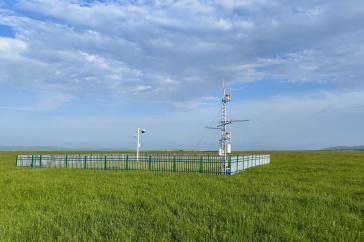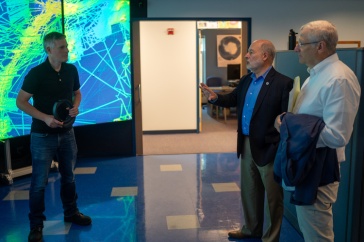
Image of an ash particle from the Mount St. Helens volcanic eruption of 1980 collected almost 400 miles away in Montana. The particle's shape and size provides important information on how clouds of volcanic ash travel, but due to the complexity of reconstruction, imaging alone cannot capture the entire particle. (Ash sample courtesy of Adam Durant, University of Oslo; image captured by Mark Townley, UNH University Instrumentation Center.)
New UNH research inspired by the 1980 eruption of Mount St. Helens will help scientists measure, and thus predict the movement of, tiny particles like ash from volcanic eruptions.
“Tiny volcanic ash particles enter the atmosphere and can be transported long distances causing all kinds of problems, from becoming an aviation hazard to affecting respiratory health for both humans and animals,” says Gopala Mulukutla, a research scientist in the Institute for the Study of Earth, Oceans, and Space at UNH. He is the lead author of a study, recently published in the journal Measurement Science and Technology, that describes an inventive technique to estimate, mathematically, the extent of an object that is captured in 3-D models, and to use the information to more accurately measure the entire object.
“By using this mathematical approach, we can gain a better idea of what the particles look like, which will allow scientists to implement models that better predict movement of volcanic ash clouds of future eruptions,” Mulukutla adds.
Due to their tiny size, irregular shape and limited viewing angle, particles the size of a grain of sand or smaller can’t be fully captured by commonly used microscopic imaging techniques, which often leave out valuable information that can be important in numerous areas of science, engineering and medicine.
“Micro-scale 3-D models are an important tool for many areas of science, but for most micro- or nano-scale objects, only a portion of the object can be seen in the field of view,” says Mulukutla. He and his co-authors developed a mathematical technique that reasonably computes what those models can’t see to allow for a more accurate assessment of properties such as surface area and volume of the entire particle.
The research was inspired by a National Science Foundation-funded study to understand the properties of volcanic ash collected from the eruption of the Mount St. Helens volcano in the state of Washington. Ash from deadly eruptions like this one can spread far and wide and cause issues related to health, air transportation and even crop failure.
Part of a provisional patent filed by UNHInnovation, the technique has other practical applications. Mulukutla, whose research area is in hydrology and water quality, says it could be useful in developing models that simulate how sediment moves through rivers and streams. The technique might also be helpful in medicine, where, for example, new and innovative blood tests being developed require assessing the shape and properties of elongated blood droplets that can be challenging to capture.
This work was supported by US National Science Foundation (NSF) grants (EAR-0838292 and MRI-1337897).
For more information on licensing this patent-pending technology, contact unh.innovation@unh.edu.
-
Written By:
Beth Potier | UNH Marketing | beth.potier@unh.edu | 2-1566




















































